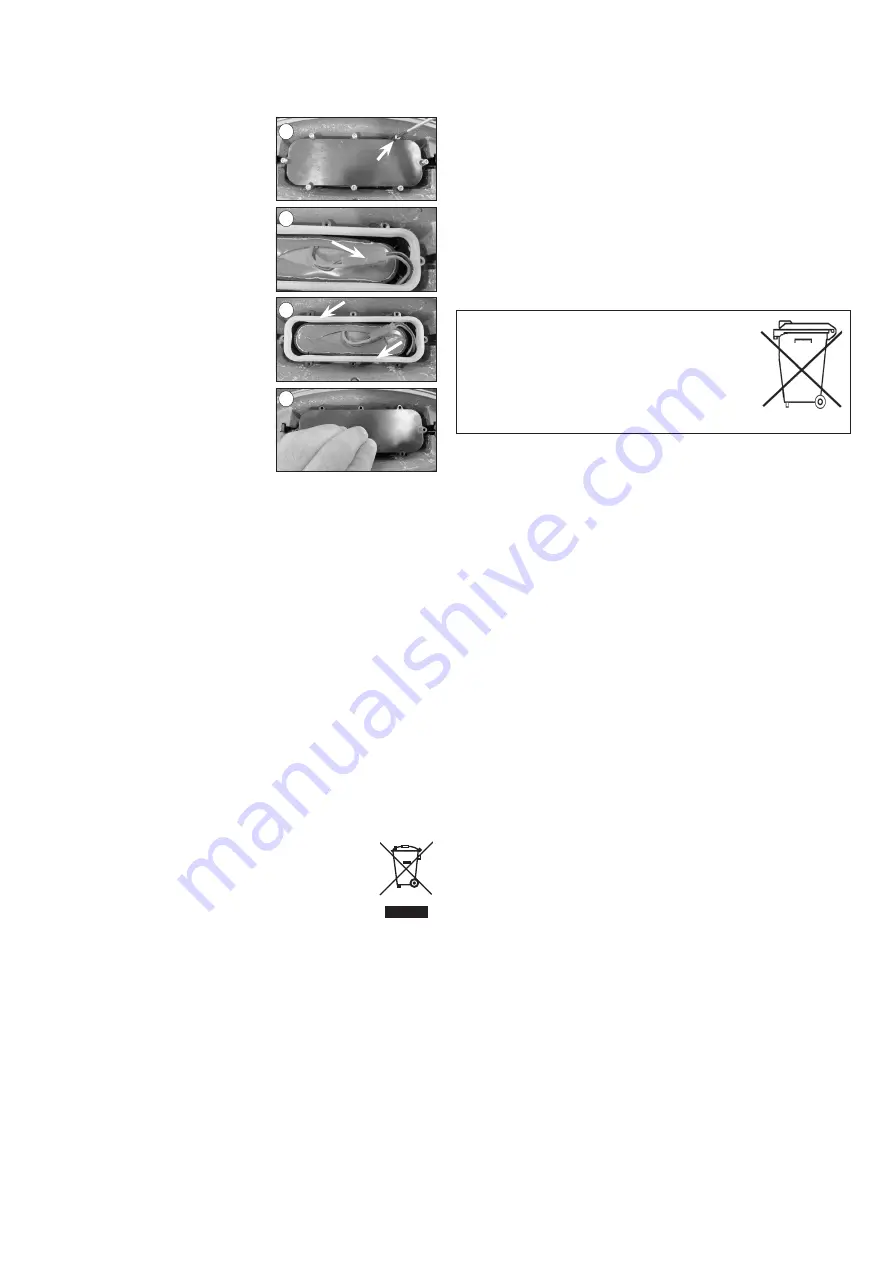
7. Changing the battery pack
The battery pack should be replaced by an authorised specialist or by your
dealer. The dealer should proceed as follows:
1. Switch off the light.
2. Turn out all 4 screws from the side of
the lamp and remove the lamp from the
mounting plate upwards.
3. Open the 8 screws on the battery com-
partment (figure 1) on the underside
of the lamp and carefully remove the
cover.
4. Release the connection of the battery
pack (Fig. 2) and exchange the battery
pack for an equivalent one.
Note: The plug is protected against
reverse polarity. Please do not use
force.
5. Now place the seal from the cover back
onto the battery compartment (Fig. 3)
and press the cover firmly back onto the
seal of the battery compartment (Fig. 4).
6. Now insert the screws and tighten them
again with a suitable screwdriver.
7. Mount the lamp again and select the
desired mode.
Note: Used batteries or accumulators must be disposed of in an environ-
mentally friendly manner and should not be disposed of with household
waste. Your dealer is legally obliged to take back the old batteries.
8. Technical Data
• PIR sensor:
160°, range max. 10 m
• Illuminant:
20 LEDs on each side
• Light angle:
120°.
• Light colour:
3000 K warm white
• Luminous intensity: Max. 1000 lm on each side
• Battery:
LiFePo4 6.4 V/ 6000 mAh
• Protection class: IP 65
• Protection class: III
• Temperature range: -20°C to +45°C
Manufacturer/Importer:
esotec GmbH - Gewerbegebiet Weberschlag 9 - D-92729 Weiherhammer
Tel.-Nr: +49 9605-92206-0 - Fax.-Nr: +49 9605-92206-10
Internet: www.esotec.de
Disposal:
Dear customer,
please cooperate in avoiding waste. When you intend to dis-
pose of the product in future, please consider that it contains
valuable raw materials suited for recycling.
Therefore, do not dispose it of with domestic waste but bring
it to a collection point for the recycling of waste electrical
and electronic equipment. Thank you very much for your
cooperation!
Copyright, esotec GmbH
Battery Recycling:
- Used batteries or accumulators must be disposed in the
domestic waste.
- The consumer is legally obliged to bring back old accumula-
tors upon usage, e.g. to public waste collecting locations or
to the place (shops, etc.) where those batteries are sold.
- Batteries that contain harmful substances are marked with
the “strike through dustbin” and one of the chemical sym-
bols.
LiFePO4
Rechargeable battery notes
- Rechargeable batteries should not be played with by children. Never
leave rechargeable batteries lying around; they could be swallowed by
children or pets.
- Rechargeable batteries must never be short-circuited, disassembled or
thrown into fire. This leads to a danger of explosion!
- Leaking or damaged rechargeable batteries can cause chemical burns
when they come into contact with skin. For this reason, please make use
of suitable protective gloves.
- Rechargeable batteries should only be replaced by structurally identical
rechargeable batteries from the same manufacturer. Normal batteries
must not be used since these are not rechargeable.
- Make sure the rechargeable batteries are inserted with the correct pola-
rity.
- For long periods of time of non-use (for example, storage), remove the
inserted rechargeable batteries to avoid damages via the leaking rechar-
geable batteries.
1.
2.
3.
4.













